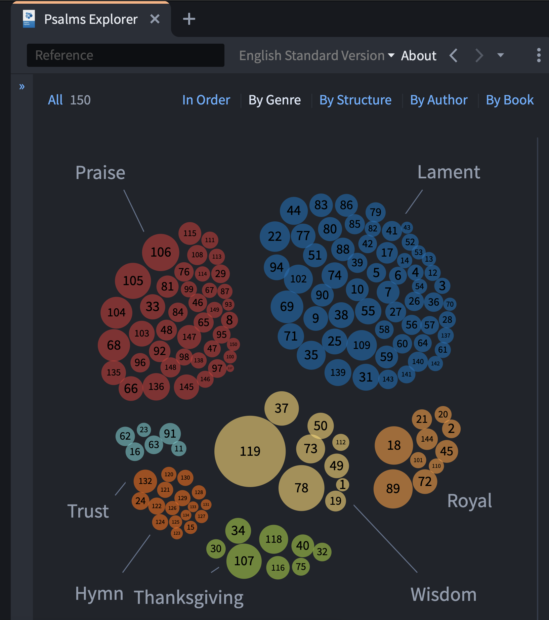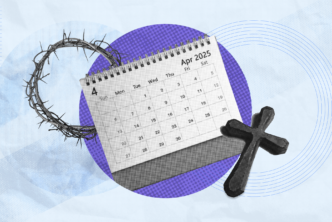If spiritual disciplines are those practices which form us spiritually, there can be none so important as prayer—our conversation with God, our Lord and Creator. Yet this most simple and most important of the disciplines can sometimes be the hardest.
At least, that is how I’ve often felt. I wanted to commune with God.
“But as for me, my prayer is to you, O Lord.
At an acceptable time, O God,
in the abundance of your steadfast love answer me in
your saving faithfulness.”
—Psalm 69:13
I wanted to know I was not sitting alone, in seeming silence, for no reason. And, from talking with others, I know I am not alone in this experience and these questions.
We want to hear God, and we want to know that he hears us. But we often wonder if we are praying in the “right way,” or if it really is possible to hear from God, or if there is any point to this practice. So, how do we move beyond the feeling that we pray in order to check off a box on our spiritual to-do list? How might we embrace both duty and delight in our prayer practice?
What is prayer?
Why pray?
Types of prayer
What the Bible says about prayer
Ways to pray
More resources for prayer
What is prayer?
At its simplest, prayer is communion with God. If spiritual disciplines are practices designed to draw us closer to God and to transform us through the work of the Holy Spirit, prayer is the discipline that underpins all the others.
Prayer is also relationship and a way to “provide patterns for attending to God throughout the day.”1
As Richard Foster writes in Celebration of Discipline: The Path to Spiritual Growth,
Of all the Spiritual Disciplines prayer is the most central because it ushers us into perpetual communion with the Father. Meditation introduces us to the inner life, fasting is an accompanying means, study transforms our minds, but it is the Discipline of prayer that brings us into the deepest and highest work of the human spirit….To pray is to change. Prayer is the central avenue God uses to transform us. If we are unwilling to change, we will abandon prayer as a noticeable characteristic of our lives.2
These are challenging words from Foster. They might make us question ourselves if we find we are not praying often. He continues, expounding on the words of James,
“You ask and do not receive, because you ask wrongly, to spend it on your passions” (James 4:3). To ask “rightly” involves transformed passions. In prayer, real prayer, we begin to think God’s thoughts after him: to desire the things he desires, to love the things he loves, to will the things he wills. Progressively, we are taught to see things from his point of view.”3
If we are struggling with prayer, is it because we are unwilling to change? That may be the case.
However, it may be not so much that we are unwilling but that we are not quite sure how to pray. It may be the forms we have been using do not seem to be working. Or that we are being invited into a deeper walk with God. Foster’s chapter on prayer is focused on intercessory prayer, and he recommends Andrew Murray’s With Christ in the School of Prayer as a resource for those desiring to go deeper into other aspects of prayer.
Here I find it helpful (and relieving!) to recall that prayer is not dependent on us “getting it right.” Instead, we can be confident because “the Spirit helps us in our weakness. For we do not know what to pray for as we ought, but the Spirit himself intercedes for us with groanings too deep for words” (Rom 8:26).
Additionally, as Foster reminds us, “Sometimes we are afraid that we do not have enough faith. … Our fears should be put to rest, for the Bible tells us that great miracles are possible through faith the size of a tiny mustard seed.”4
***
To learn more about prayer and what the Bible tells us about it, check out the Factbook feature [Logos > Tools > Factbook >Prayer] and the Bible Word Study guide [Logos > Guides > Bible Word Study] in the Logos Bible app. It’s available free for mobile, web, or desktop.
***
Before we go further into different types of prayer and ways to pray, let’s look a bit more into why we pray.
Why pray?
God has invited us to be in a relationship with him. As we see modeled in Scripture, relationship with God involves communion with him—a two-way exchange of speaking and listening. We can turn to any number of examples in the Bible. The Psalms in particular show us what conversation with God can look like—and that we can talk to him about anything! The Psalms are always a good place to turn if we are searching for words for our prayers.

If that were not enough, we have the example of Jesus. He often taught about prayer, and he often went away by himself to pray, to be alone with his Father (see Matt 14:23, Mark 6:46, Luke 5:16). His expectation is that those who follow him will also pray. “When you pray,” he says during his Sermon on the Mount (see Matthew 6).
It is notable that the disciples, who would have been surrounded by Jewish traditions and examples of prayers, ask Jesus “teach us to pray” (see Luke 11). And Jesus does. He teaches them—and us—to come to his Father like children (see Matthew 6 and 18).
The Lord’s Prayer
Our Father in heaven,
hallowed by your name.
Your kingdom come,
your will be done,
on earth as it is in heaven.
Give us this day our daily bread,
and forgive us our debts,
as we also have forgiven our debtors.
And lead us not into temptation,
but deliver us from evil.
For yours is the kingdom
and the power and the glory, forever.
Amen.
Resources to study the Lord’s Prayer

My Utmost for His Highest Revised: An Updated Edition in Today’s Language
Regular price: $14.99
Hearing God: Developing a Conversational Relationship with God (audio)
Regular price: $14.98
Prayer: How Praying Together Shapes the Church (9Marks Building Healthy Churches Series)
Regular price: $9.99
Types of prayer
There are many types of prayer: individual, corporate, intercessory, praise, petition, lament, thanksgiving, extemporaneous, written, and fixed-hour, to name just a few. Prayers can be aloud or silent, verbal or wordless. Often prayers combine multiple elements. In Jesus’ example above, he models direct address, praise, petition, and repentance in the space of a short prayer.
What the Bible says about prayer
Prayers do not have a prescribed length. Jesus’ teaching and ministry demonstrate that length of prayer or particular turn of praise are not what God is looking for. In Luke 18, we read his parable about the Pharisee and the tax collector who go to the temple to pray. The Pharisee enumerates on his virtues, while the tax collector says, “God, be merciful to me, a sinner.”
Later on, in the same chapter, we read about the blind man on the roadside as Jesus passes by. He insistently cries out, “Jesus, Son of David, have mercy on me!” despite those around him trying to silence him. Jesus responds with compassion and healing to this man’s earnest prayer and request.
As Adele Calhoun writes in her Spiritual Disciplines Handbook: Practices That Transform Us, “Prayer is sustained less by duty than by a desire to connect and grow in intimacy and communion with the holy Three.”5
Jesus’ parables tell us what it is to seek him (see Luke 15). And God tells us, through the prophet Hosea, “For I desire steadfast love and not sacrifice, the knowledge of God rather than burnt offerings” (Hos 6:6).
More verses on prayer
“Moreover, as for me, far be it from me that I should sin against the Lord by ceasing to pray for you, and I will instruct you in the good and the right way” (1 Sam 12:23).
“And you, Solomon my son, know the God of your father and serve him with a whole heart and with a willing mind, for the Lord searches all hearts and understands every plan and thought. If you seek him, he will be found by you, but if you forsake him, he will cast you off forever” (1 Chr 28:9).
“If my people who are called by my name humble themselves, and pray and seek my face and turn from their wicked ways, then I will hear from heaven and will forgive their sin and heal their land” (2 Chr 7:14).
“O God, hear my prayer; give ear to the words of my mouth” (Ps 54:2).
“With my whole heart I seek you; let me not wander from your commandments” (Ps 119:10).
“I love those who love me, and those who seek me diligently find me” (Prov 8:17).
“Seek the Lord while he may be found; call upon him while he is near” (Isa 55:6).
“for my house shall be called a house of prayer for all peoples” (Isa 56:7).
“You will seek me and find me, when you seek me with all your heart” (Jer 29:13).
“And going a little farther he fell on his face and prayed, saying, ‘My Father, if it be possible, let this cup pass from me; nevertheless, not as I will, but as you will’” (Matt 26:39).
“And Jesus answered them, ‘Have faith in God. Truly, I say to you, whoever says to this mountain, ‘Be taken up and thrown into the sea,’ and does not doubt in his heart, but believes that what he says will come to pass, it will be done for him. Therefore I tell you, whatever you ask in prayer, believe that you have received it, and it will be yours. And whenever you stand praying, forgive, if you have anything against anyone, so that your Father also who is in heaven may forgive your trespasses” (Mark 11:22–25).
“And he told them a parable to the effect that they ought always to pray and not lose heart” (Luke 18:1).
“And all these [the disciples] with one accord were devoting themselves to prayer, together with the women and Mary the mother of Jesus, and his brothers” (Acts 1:14).
“About midnight Paul and Silas were praying and singing hymns to God, and the prisoners were listening to them” (Acts 16:35).
“Rejoice in hope, be patient in tribulation, be constant in prayer” (Rom 12:12).
“You also must help us by prayer, so that many will give thanks on our behalf for the blessing granted us through the prayers of many” (2 Cor 1:11).
“do not be anxious about anything, but in everything by prayer and supplication with thanksgiving let your requests be made known to God” (Phil 4:6).
“praying at all times in the Spirit, with all prayer and supplication. To that end, keep alert with all perseverance, making supplication for all the saints” (Eph 6:18).
“Continue steadfastly in prayer, being watchful in it with thanksgiving” (Col 4:1).
“pray without ceasing” (1 Thess 5:17).
“First of all, then, I urge that supplications, prayers, intercessions, and thanksgivings be made for all people, for kings and all who are in high positions, that we may lead a peaceful and quiet life, godly and dignified in every way” (1 Tim 2:1–2).
“For everything created by God is good, and nothing is to be rejected if it is received with thanksgiving, for it is made holy by the word of God and prayer” (1 Tim 4:5).
“Therefore, confess your sins to one another and pray for one another, that you may be healed. The prayer of a righteous person has great power as it is working” (Jas 5:16).
“And when he had taken the scroll, the four living creatures and the twenty-four elders fell down before the Lamb, each holding a harp, and golden bowls full of incense, which are the prayers of the saints” (Rev 5:8).
See more topical Bible verses.
Continually seeking
As we’ve seen above, God wants us to seek him and he responds when we seek him. This can look many different ways. Let’s explore some of the ways we can grow in communing with God.
Ways to pray
There are many great resources offering guidance on prayer practices we can try as we seek to spend time with God.
7 Ways to Pray
Amy Boucher Pye’s book, 7 Ways to Pray: Time-Tested Practices for Encountering God, available in ebook or audiobook format, is one such excellent resource. Amy’s approachable style, succinct descriptions, and practical suggestions encourage readers in exploring new (though actually quite ancient) forms of prayer and conversation with God. Each chapter includes stories and personal anecdotes, biblical support for the practice described, and sample exercises for individuals or groups.
As Pye writes in her introduction,
On this journey together, we’ll experience praying with and through the Bible, practicing God’s presence, hearing God, praying through lament, praying imaginatively, and praying the examen. These practices have been around for centuries in various forms, but they are as relevant today as when people first used them to encounter our living God—the Trinity of God the Father, God the Son, and God the Holy Spirit.6
Pye offers multiple prayer practices related to each chapter’s focus, and she encourages readers to skip around to what interests them. Many of the practices are oriented around praying directly with the words of Scripture, including Lectio Divina, personalizing Scripture, praying with the Psalms, and practicing Lament. Lectio Divina translates to “sacred reading” and is a practice of slowly reading a Scripture passage aloud multiple times, with pauses in between each reading in order to reflect, meditate, and pray.
Other practices in 7 Ways to Pray might feel less familiar to us, depending on which Christian tradition we find ourselves in, such as breath prayers, practicing the presence, and praying imaginatively.
Praying imaginatively was certainly new for me when I was introduced to it, and I found it a very enriching experience, particularly with Amy’s guidance. She periodically offers an online prayer retreat series based on her book. I went through this last year, and it was so lovely to gather each week for an hour with Christians from around the world, learn a new practice, and pray together.
In our relationships in this life, we understand that time and conversation are crucial to us knowing one another. The same is true for our relationship with God. Pye encourages,
God wants us to enjoy a relationship of trust with him, where we come to know him intimately through conversation and spending time together. As we seek him and his direction, listening for his leading and obeying him when we sense the way forward, we grow in confidence and in union with him.7
A good place to start, of course, is to ask God for his guidance. Pye includes a sample prayer we can use when beginning a new practice:
“Father, Son, and Holy Spirit, open my heart and my mind to receive you during this journey of prayer. Teach me from your well of wisdom as I drink deeply at the source. Strengthen my ability to discern your truth as you drench me with your love and compassion. Amen.”8
Spiritual Disciplines Handbook
In the Spiritual Disciplines Handbook, Calhoun devotes an entire section to prayer, offering fourteen types of prayer: Breath Prayer, Centering Prayer, Contemplative Prayer, Conversational Prayer, Fasting, Fixed-Hour Prayer, Inner-Healing Prayer, Intercessory Prayer, Labyrinth Prayer, Liturgical Prayer, Prayer Partners, Praying Scripture, Prayer of Recollection, and Prayer Walking. Such disciplines of prayer “open us to the divine dialogue through intentional encounter with the Trinity” and “open our gaze and hearing to God.”9
Just as there are not certain words that must be said in a certain way for prayer to happen, so a particular physical posture is not required. This does not mean it is not important. Physical posture can affect our levels of concentration. Or, we might find that certain postures complement certain types of prayers, such as kneeling in petition or repentance, or standing in praise.
Calhoun reminds us,
Often the exercises [in the Handbook] invite you to sit comfortably in a chair and become present to God. Though the posture of sitting for prayer is not necessarily rooted in biblical examples, it is the posture most of us in Western culture assume in order to concentrate on something or someone. Posture is an important part of prayer. The ancient Jews believed that prayer began with an intentional awareness of God’s presence: know “before whom you are standing” (Berakhot 28b). The inward posture of the heart preceded all outward postures for prayer.”10
Recognizing that the inward posture precedes any outward posture, Calhoun invites readers to explore the various prayer postures that are mentioned in the Bible: standing, outstretched arms, uplifted eyes, and kneeling.11
Practical Studies: Prayer Collection
Sometimes our prayer practices may benefit from further study on prayer and the thoughts of other Christians throughout the centuries. The Practical Studies: Prayer Collection (12 vols.) contains an assortment of prayer resources both theological and devotional with writings from Tertullian, Calvin, Spurgeon, Wright, and others.
The Logos edition of Practical Studies includes textual links to Bible passages, theological terms, and other resources in your Logos library.
Another practical resource we mentioned earlier is Andrew Murray’s With Christ in the School of Prayer. If you’re looking for guidance, this month-long study and practice of prayer offers thirty-one meditations on prayer.
In the Logos edition, all Scripture passages are tagged and appear on mouse-over. For scholarly work or personal Bible study, this makes these texts more powerful and easier to access than ever before. With the advanced search features of Logos, you can perform powerful searches by topic or Scripture reference—finding, for example, every mention of “holiness” or “John 15:1–2.”
Praying with the arts
If you are moved by or drawn to the arts, there are a number of devotional approaches to prayer that incorporate sacred art, poetry, or your own creations.
Visio Divina
Visio Divina (“divine seeing”) is similar to Lectio Divina in the way it invokes a slowing down and a contemplation of Scripture. With Visio Divina, this contemplation has the additional aid of a piece of art. For an overview, check out spiritual director Mary Gardner’s “Praying with our eyes: the practice of Visio Divina.” In her short article, she outlines four basic steps (reading, meditating, praying, and contemplating) and shares examples of art and reflection questions.
“Art for faith’s sake”
If you find visual contemplation beneficial and would like to incorporate a regular practice throughout the year, either individually or in a group, consider Praying with the Arts: Illuminating the Church Year with Sacred Art. Louise Holert’s Praying with the Arts offers a devotional prayer approach to sacred art that is centered on the Incarnation. As she describes it, it is “art for faith’s sake.”12
She writes in her introduction,
Following the calendar of the liturgical (church) year from Advent to Christ the King Sunday (the last Sunday of the liturgical year), the book introduces sacred art masterpieces, along with Scripture, as prayer companions. The masterpieces of sacred art nurture a fresh perspective on the Biblical narrative” and “help the reader participate afresh in the life, death, resurrection, and ascension of Jesus Christ.13
Praying in Color
In Praying in Color, Sybil MacBeth recounts her struggles with focus during verbal prayers, and she offers an alternative. As she describes it, “Praying in Color is the intersection of prayer and doodling. It is a visual, active, meditative, and playful way to pray.”14
In addition to her books, she offers some simple practices and free resources to get you started on her website.
“More than an order of words”
As T. S. Eliot aptly tells us in “Little Gidding,” “And prayer is more / Than an order of words, the conscious occupation / Of the praying mind, or the sound of the voice praying.” Poetry, though, can capture something in a way our prose does not, assisting our approach to what we cannot describe.
In Marilyn McEntyre’s book, When Poets Pray, she offers meditations on twenty-four poems, from the ancient to the contemporary. As she writes in her introduction,
Poets have enriched my prayer life by giving me lines that lift up my heart, or words for lament, or images that widen my awareness—of the grandeur of God flaming out “like shining from shook foil,” or of a “beauteous evening, calm and free” when “the holy time is quiet as a nun / breathless with adoration.”15
Praying with rosaries
A rosary usually refers to a physical item, such as a string of beads or a knotted rope, while the Rosary refers to a specific Catholic prayer practice. The idea of praying with a physical item, such as prayer beads, might feel unfamiliar if you—like me—do not come from a religious tradition that uses them regularly. One way to consider prayer beads is simply as a devotional aid: a guide and a physical object that helps one focus. While a number of Christian traditions (as well as other religions) use such aids, we’ll take a look at just three practices.
Catholicism: The Rosary
The Rosary, as practiced by the Catholic Church, is probably the most familiar to many of us, or at least, we’ve heard of the Rosary and associated it with Catholicism. The United States Conference of Catholic Bishops offers a helpful guide on their website for praying the Rosary, which shares:
The Rosary is a Scripture-based prayer. It begins with the Apostles’ Creed, which summarizes the great mysteries of the Catholic faith. The Our Father, which introduces each mystery, is from the Gospels. The first part of the Hail Mary is the angel’s words announcing Christ’s birth and Elizabeth’s greeting to Mary. St. Pius V officially added the second part of the Hail Mary. The Mysteries of the Rosary center on the events of Christ’s life. There are four sets of Mysteries: Joyful, Sorrowful, Glorious and—added by Saint John Paul II in 2002—the Luminous. The repetition in the Rosary is meant to lead one into restful and contemplative prayer related to each Mystery. The gentle repetition of the words helps us to enter into the silence of our hearts, where Christ’s spirit dwells. The Rosary can be said privately or with a group.
Other helpful guides are offered from the Catholic Encyclopedia and from Hallow.
Orthodoxy: The Jesus Prayer
The Orthodox practice of praying with prayer beads is different from the Catholic Rosary. As described on the website for the Orthodox Church in America,
In Orthodoxy there is, however, the practice of praying the Jesus Prayer—“O Lord, Jesus Christ, Son of God, have mercy upon me, a sinner”—on a set of prayer beads, generally 100 in number. This tradition is especially upheld by Orthodox monks and nuns, although a growing number of laypersons also make use of such beads.
Anglicanism: Christ’s life on earth
Anglican prayer beads generally have “thirty-three beads, representing Christ’s life on earth … linked together in a circular manner that begins and ends on the cross.”16
In this tradition, there seems to be less emphasis on praying certain prayers in a certain order and more on using the beads as a meditation and prayer aid as the individual sees fit.
Prayer apps
One way, I’ve found, to try new forms of prayer in a way that is not overwhelming is by using a prayer app. Prayer apps often have short guided experiences that you can listen to (any time and almost anywhere!).
The Pray-as-you-go app offers free daily meditations. Generally they are around ten minutes or so, and include a sacred song, a Scripture reading, and reflection prompts for contemplation and prayer. The space between the reading and reflection gives you time to reflect without needing to set a timer. This is a great way to start building up a daily practice of prayer, including listening and silence.
Lectio 365 is an app developed by 24-7 Prayer International. Lectio 365 is inspired by the practice of Lectio Divina. This free devotional resource is designed to help you pray with the Bible every day, with morning and evening offerings that help you frame your day with God’s Word.
Hallow—is a Catholic meditation app. While it does require either a monthly or annual subscription, you can sign up for a three-month free trial. Besides the variety of options for prayer, meditation, music, and sleep, there is the ability to really personalize your prayer time. You can select different lengths of time for your sessions, change the background (such as silence, chanting, or ambient tones), and build routines or community groups within the app.
A note about prayer aids
Since we’ve talked a lot about aids for prayer in this section, I think it is helpful to reiterate that is all these are: aids. They are not requirements, nor will they make us holy. God has offered us direct access to himself, through his Son, through his Word, and through the indwelling of the Holy Spirit. Any practices are attempts to enter into this invitation in a deeper way, and not the way itself.
Sometimes embracing a new exercise can help slow us down and consider things in a new light. It can help open up our understanding and consider anew practices or texts that have become so familiar to us. Repetition lets things sink into our soul, but there is always the danger of something becoming rote if we are not intentional about it.
More resources for prayer
As we’ve illustrated, there are many practices we can explore to further our relationship with God. These practices can form us spiritually in both tangible and intangible ways. The more we practice and the more we study, the more we grow, with the aid of the Holy Spirit.
Are you looking for further study? You might want to check out some of the courses or books below.

My Utmost for His Highest Revised: An Updated Edition in Today’s Language
Regular price: $14.99

Psalms: Prayers of the Heart: 12 Studies for Individuals or Groups: With Notes for Leaders
Regular price: $5.99
Hearing God: Developing a Conversational Relationship with God (audio)
Regular price: $14.98
Prayer: How Praying Together Shapes the Church (9Marks Building Healthy Churches Series)
Regular price: $9.99
Related articles
- Good Morning! 20 Powerful Prayers to Start Your Day
- Good Night! 18 Prayers to Close Your Day
- 8 Prayers to Pray for Your Pastor
- Old Testament Prayers: These 3 Could Redirect Your Life
- 8 Honest, Powerful Prayers in the Bible
- Adele Ahlberg Calhoun, Spiritual Disciplines Handbook: Practices That Transform Us (Downers Grove, IL: InterVarsity Press, 2005), 203.
- Richard Foster, Celebration of Discipline: The Path to Spiritual Growth (New York, NY: HarperCollins, 2018), 33.
- Foster, Celebration of Discipline, 33.
- Foster, Celebration of Discipline, 39.
- Calhoun, Spiritual Disciplines Handbook, 203.
- Amy Boucher Pye, 7 Ways to Pray: Time-Tested Practices for Encountering God (Colorado Springs, CO: NavPress, 2021), 5.
- Pye, 7 Ways to Pray, 17.
- Pye, 7 Ways to Pray, 7.
- Calhoun, ,203.
- Calhoun, Spiritual Disciplines Handbook, 203.
- Calhoun, Spiritual Disciplines Handbook, 276–77.
- Louise M. Holert, Praying with the Arts: Illuminating the Church Year with Sacred Art (Abbotsford, BC, Canada: Infocus Publishing, 2018), 3.
- Holert, Praying with the Arts, 2.
- Sybil MacBeth, “Author Bio,” Praying in Color, https://prayingincolor.com/bio-books.
- Marilyn McEntyre, When Poets Pray (Grand Rapids, MI: Wm. B. Eerdmans Publishing Co., 2019), 2.
- Jenny Estes, The Anglican Rosary: Going Deeper with God—Prayers and Meditations with the Protestant Rosary (Oklahoma City, OK: Theophany Press, 2019).








